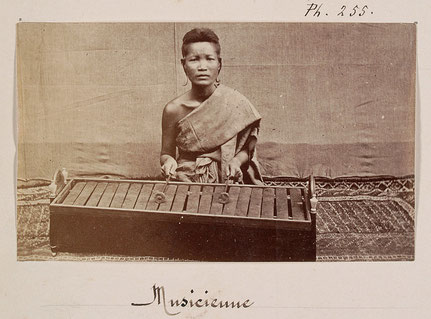Last update: December 5, 2023
General

Roneat dek រនាតដែក (roneat deik/daek) literally means "iron/metal blade instrument". In the common Khmer language, the term dek ដែក is used to designate iron, but also metal when it is not precious (excluding gold and silver in particular). Almost all roneat dek have iron blades. Exceptionally, some are equipped with bronze blades, as at the Wat Reach Bo in Siem Reap (see pictures below).
Contrary to the xylophones roneat ek and roneat thong, the roneat dek's blades are installed flat and not curved. Its blades cannot be tuned by the musicians; the tuning is final at the time of manufacture. It is obtained after the melting of the blades by polishing.
The trapezoidal soundboard is made of wood with parallel walls joined by a board at the base.
This instrument is played only in the pin peat ensemble where its presence is rare.
Like the roneat ek and roneat thong, it sometimes comes in two registers: roneat ek dek and roneat thong dek. Most of the time, only one roneat dek officiates. It/they bring(s) a precious clarity to the orchestra.
Historicity
Numerous undocumented beliefs and assertions are flooding the scientific and general public literature. Therefore we will not express ourselves on this subject.
The two roneat dek previously described are analogous to the ranat ek lek and ranat thum lek of Thailand which would have been born under the reign of King Mongkut The Great, also known as King Rama IV (1854-1868). *SEAsite.
In Cambodia, the first evidence of their existence is known to us thanks to the French photographer Émile Gsell who photographed the instruments below around 1866-1870 in the Royal Palace of Phnom Penh.
Pin peat ensemble of the Royal Palace of Cambodia
On December 3, 2017, more than 5,000 Buddhist monks were invited by the Royal Government of Cambodia for a peace offering ceremony at Angkor Wat. The Royal Palace's pin peat ពិណពាទ្យ plays traditional music while worshippers make offerings to the monks. Here, a single roneat dek officiates, to the right of the roneat ek (from the musicians' point of view). It has 21 bronze blades (numbered) that are slightly concave. The plan of the blades appears rectangular, not trapezoidal, because all the blades are of equal length (although this should be checked).
Pin peat ensemble of Wat Reach Bo
The pin peat of Wat Reach Bo (Siem Reap) has two bronze blade roneat dek but here, only the roneat thong dek is played. Note the fixing device of the 17 blades with the holes located at 2/9 of the total length.
This sequence was shot in 2015 during the festival of Pchum Ben.







